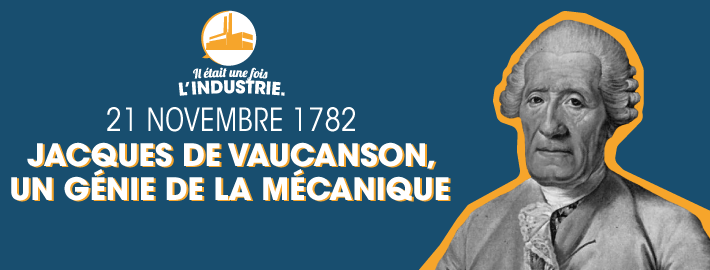GLOBAL
INDUSTRIE
News
Share on

21 November 1782: Jacques de Vaucanson, a mechanical genius
This week, we tell you the story of one of the fathers of mechanics and automata, a man still very much part of our everyday lives, both technologically and artistically...
AN EARLY CALLING
Jacques de Vaucanson was born on the 24th of February 1709 in Grenoble into a large middle-class family. In spite of this, it was to overcome his loneliness that this glove-maker’s son revealed his exceptional mechanical abilities at a very early age. His mother took him every Sunday to visit local dowagers, who were quick to get the burdensome little boy out of the way by relegating him to a bedroom containing an old clock. Fascinated by the movement of the pendulum, the secrets of which he quickly grasped, he made his first clock with the means available to him. His reputation quickly spread around the neighborhood, where he repaired watches and chimes.
Tempted for a time by a religion, he took his vows in 1727 but quickly gave them up, considering the Church to be too remote from his first loves of science and technology. He then went to Paris to study mechanics, physics, anatomy and music from 1728 to 1731.
DUCK ART AND MUSIC
He then began the construction of his first automaton, which has gone down in history as the "Flute Player". Sitting on a rock, this life-size flutist with moving fingers, lips and even breath, was a big success. He repeated the feat with a second, even more sophisticated model which took the form of a Provence shepherd simultaneously playing the tambourine and the galoubet, a flute which is difficult to master due in particular to the complex tongue movements involved. His third model, a "digesting duck", nevertheless remained his great masterpiece: this web-footed creature, exhibited at the Palais Royal in 1744, was capable of eating, digesting, quacking and swimming thanks to a complex mechanism visible in its pedestal. Its strikingly realistic wings were reproduced bone by bone. Unfortunately, these three technological achievements were all to disappear at the end of the 19th century and all that remains of them is engravings or poor-quality photographs.
A DONKEY WITH A MESSAGE
His reputation having spread beyond France, he was only 32 when Frederick II of Prussia, who was trying to surround himself with Europe’s greatest talents, offered to pay him handsomely to join him. He nevertheless turned down this lucrative offer, preferring to remain in France where he agreed in 1741 to take up the position of general inspector of silk manufactures, an industry which Louis XV wished to reorganize. He then abandoned his work on automata to devote himself to improving the various machines used in this field. He automated looms in particular, his work later influencing that of Joseph Jacquard. These technical improvements, which made work simpler, earned him some bitter enemies among workers in Lyon, who claimed to be the only people capable of producing certain fashionable patterns. After being chased through the streets of the city by workers pelting him with stones, he took revenge by building a machine, still visible at the Conservatoire des Arts et Métiers, featuring a donkey capable of producing flowery material! He was also credited with the invention of the first metal lathe, the creation of a chain which was named after him and the creation of a machine capable of manufacturing equal links.
It was therefore only natural that in 1746 this great mechanical engineer, who contributed in his spare time to the drafting of the Encyclopedia directed by Diderot and D’Alembert, was admitted to the Academy of Science. When he died at 73 on the 21st of November 1782, he left all of his machines to King Louis XVI, who quickly purchased the Hôtel de Mortagne, his home, to house the Cabinet des Mécaniques du Roi, forerunner of the Conservatoire National des Arts et Métiers.
Jacques de Vaucanson also inspired several leading authors: we thus find numerous tributes to his talent in comic books – particularly those of Joann Sfar -, in literature – with Voltaire, Jean-François Parot, Thomas Pynchon but also Frank Herbert, author of Dune -, video games, cinema, television, etc.
"While rival of the old Prometheus’ fame, Vaucanson brings to man celestial flame. Boldly to copy nature’s self aspires, And bodies animates with heavenly fires" – Voltaire
OTHER EVENTS WHICH HAPPENED THIS WEEK:
- 15 November (1988): first flight of the Soviet space shuttle Buran
- 17 November (1970): the American engineer Douglas Engelbart obtains a patent for the mouse
- 18 November (1906): birth of the Anglo-Greek engineer Alec Issigonis, designer of the Mini
- 18 November (1970): the Soviet mission Luna 17 lands an exploration vehicle on the Moon
- 18 November (2013): NASA successfully launches the MAVEN probe to Mars
- 19 November (1839): birth of the Czech engineer and industrialist Emil Škoda, founder of the mechanical construction company named after him
- 19 November (2006): Nintendo launches the Wii in North America
- 19 November (2007): launch of the first Kindle e-reader by Amazon
- 20 November (1953): the American pilot Albert Scott Crossfield reaches Mach 2 for the first time in the Douglas Skyrocket
- 20 November (1985): Windows 1.0 comes out
- 20 November (1998): the Russian rocket Proton installs the first element of the International Space Station (ISS)
2021.11.15